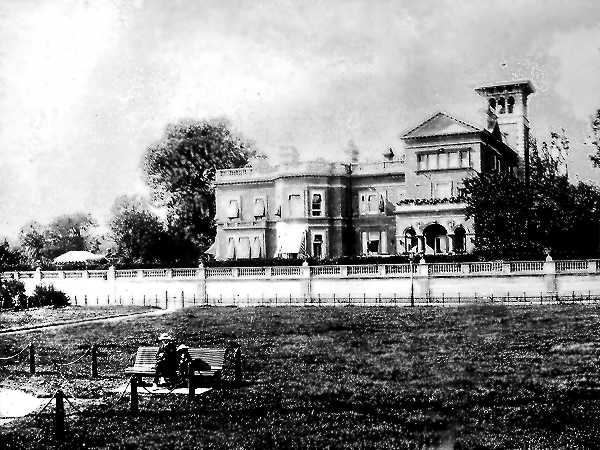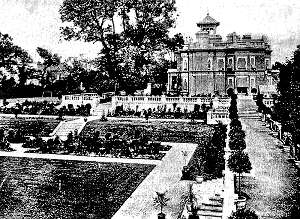Facing the beach at Walmer, Walmer Place was built in 1901 for a Dutchman, Albert Oochs, as a luxurious manor house set in 16 acres. It was bought at auction in 1909 by Agnes Marke Wood, widow of wealthy shipping merchant and banker James Marke Wood. Some accounts suggest that James bought the building and its extensive grounds but this is not the case. He had died in 1908.
It would be Mrs Marke Wood's principal residence until her death in 1927 when it was inherited by her daughter Rosamond. Both women appear to have spent many happy years in Walmer. They were extremely wealthy and generous in their support of local causes and amenities.
 |
| Walmer Place in the early 1900s: Built in 1901, the manor house set in 16 acres fell into disrepair after the second World War and was put on the market in 1958. It was sold in 1965 and the mainbuildings and gardens of Walmer Place demolished and replaced by today's apartment blocks. |
The Marke Wood Family History
Barbara Bolt, a distant relative of the Marke Wood family, contacted WalmerWeb to clarify the Marke Wood connections with Walmer Place.
In researching family history, she had discovered that Walmer Place was never the residence of the Marke Wood "family”. James and Agnes Marke Wood had three children: Esther (named after Agnes' mother but who died soon after her birth in 1878), James (born 7 May 1876) and Esther Rosamond (known by her second name and born 20 Sept 1881). Son James married but died after a short illness in May 1903, leaving no children. Daughter Rosamond married an Italian nobleman - Luigi Arborio Mella, Conte di Sant’ Elia - and took the title of Contessa Di Sant' Elia. Although they remained married, there were no children and the couple came to live, more or less, separate lives.
By the time the Walmer Place property was purchased there was only Agnes Marke Wood. However, she seems to have been visited regularly by Rosamond who, after her mother's death, continued to spend periods at Walmer Place.
The flower gardens at Walmer may have been planted by the original owner, but they were maintained and painted by Agnes. She clearly loved their Italianate-styling and considered Walmer Place her private retreat. Until the end of her life in 1927 Agnes owned a mansion in Liverpool, a house in Gloucester and a villa at Pallanza on Lake Maggiore in Italy. Barbara Bolt suggests it may have been a family visit to the villa at Lake Maggiore at the end of the 19th century that introduced Rosamond to her future husband, the Count. By 1935, though, Rosamond was keeping well away from Italy because of Mussolini – but was paying £3,000 each year to maintain her Italian in-laws.
Agnes Marke Wood was a significant local benefactor to Deal and Walmer. She endowed the Deal Victoria Hospital and contributed half of the £4,000 cost of a recreation ground in Walmer. It was opened in 1930, bearing the Marke Wood name. Before its opening Rosamond added a drinking fountain of Cornish granite ... a shaft encircled by a bronze relief of playing children and the inscription “tis love that makes the world go round”. At the unveiling she spoke of her mother’s wish “to provide a recreation area with playing fields for the people and children of Walmer....[with] meadow-type [grounds] – no building except as pavilions and shelters for recreational purposes”.
Five years after the park was named Rosamond wrote of the neglected Walmer House: “The house and grounds have been tidied up and improved...” and added “I might let it”. At this time, when staff would have been a problem, for any visits she preferred to stay in a smaller house on the estate rather than the main house which then, once more, fell into disrepair.
In 1935 Rosamond was living mostly at Warsash in Hampshire. When Italy came into the Second World War, she was “interned” at Claridges in London and is known to have lived at Grosvenor Square, London after the War. During the 1950s she continued a pre-war interest in horse-racing and was extremely successful. She died in 1965 and was buried with her parents and brother in Liverpool. The Count had died not long before, having gone to Argentina to join his nephew and eventual heir.
Following its sale in 1965, the main buildings of Walmer Place were demolished and, together with the gardens, redeveloped to create today's apartment blocks.
Barbara Bolt's detailed biography for Agnes and Rosamond and the Marke Woods family can be downloaded here.
As a postscript to her account of the Marke Wood's involvement with Walmer Place, Barbara Bolt says:
"A year or so ago I had some correspondence with a resident of the apartment block that now stands on the Walmer Place site. She was keen to acquire the gazebo as a permanent facility, but had little encouragement.
"My distant relationship with Agnes was discovered by researching family history. Her father - Halifax mill-owner Henry Charles McCrea - was the brother of my 3x great-grandmother Belinda [McCrea] Sheridan. Both Belinda and husband James died young, leaving orphan daughters. My direct ancestor was their elder daughter - also Belinda."
|
The Demolition of Walmer Place Local history enthusiast Lee Jones said (in the Deal Kent Local History facebook group): "The site was put up for sale by the Contessa in 1958 and sadly in 1965 the estate was sold and all main buildings and gardens were demolished to be replaced by the apartment blocks that stand on the site today. "Walmer Place did not go easily though, it took eight hours and eighty pounds of gelignite to bring the tower of the manor house down. The only remaining reminders of the original estate are parts of the surrounding wall, the rectangular pond and the garden house which can still be seen today." |
|
